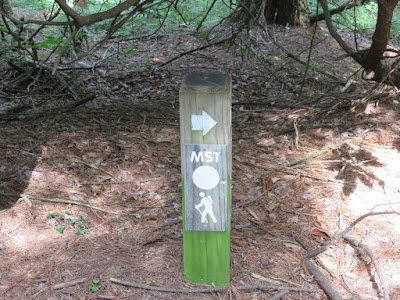 |
| Lin Cove Viaduct (MP 304) |
The Blue Ridge Parkway was not built continuously from end
to end. Construction began in 1935 as a
CCC project similar to the work on the Skyline Drive. Virginia and North Carolina purchased pieces
of the land, and donated it to the federal government to be administered as a park
by the National Park Service. The intent
was to leave as little scar as possible on the mountains, and to build a
Parkway that blended into the mountains.
Construction was difficult. Some of the areas were challenging to access, and others had rough roads
that could not transport the equipment needed to build the Parkway. Work continued until WWII and started
up again fitfully in the 1950s and 1960s.
Finally, in 1968 the Parkway was complete except for a seven mile
stretch around the fragile ecosystem of Grandfather Mountain in North Carolina.
In 1979 work moved forward to design and build the amazing
Linn Cove Viaduct (MP 304), a 1,200 foot segmented, suspended section of the Parkway
around the edges of Grandfather Mountain.
Each segment of the Viaduct is unique and fitted to the previous and
next sections by computer design. High
tension cables channel through the segments, tying them together and forming a
marvelous bridge that hugs the contours of the mountain and only touches it in a few places. You can hike beneath the Viaduct, for a
close up view of the ingenious design.
Other portions of the seven mile stretch were built between
1968 and 1987, and the completed Parkway was dedicated September 11, 1987.
 |
| Can you see the grandfather in Grandfather Mountain? |
Traveling further north we stopped at the Julian Price
Memorial Park (MP 297) and hiked around lovely Price Lake. Julian Price was an insurance magnate and
dreamed of building a place for employees of his huge insurance empire to
vacation in the mountains. His premature
death interrupted these plans and the land was donated to be part of the
Parkway. As part of the terms of the donation, Boone Fork was dammed to
create this pretty little lake. The hike
around the lake takes you through rhododendron tunnels, and hardwood
forests. It was a fun walk for us, and a
cooling swim for Tiki.
That night we stopped to boondock camp at another NPS
campground on the Parkway at Doughton Park (MP 238).
There were a few more campers here, we were starting the long July 4 weekend, but
there were many empty spots. A mile long
hike through woods and several meadows takes you from the campground to the Brinegar Cabin (also accessible by
road - MP 238.5), a simple log cabin representing how many families in the region eked out
a living on the land growing vegetables and livestock. Mr. Brinegar brought in extra money by making and selling shoes to
his neighbors.
 |
| Lovely meadow that we crossed on the way to Brinegar Cabin |
 |
| Brinegar cabin (on right) and barn (MP 238.5) |
Prior to setting out on our trip, we had checked some guide books to
the BRP out of the library. They did not
give us the information we had been wanted about the Parkway. At the Linn Cove Visitors Center we found the
book we had been hoping for, Hiking and Traveling the Blue Ridge Parkway
by Leonard M. Adkins. The book describes
what you will see at each overlook, and has maps and directions for all of the
hikes along the Parkway. We recommend
you get a copy of this book before you set out
on your own BRP adventure.
 |
| The Mountain to the Sea Trail (MST) starts in the Smokeys and ends on the Outer Banks. Some parts are still being "planned." |






No comments:
Post a Comment